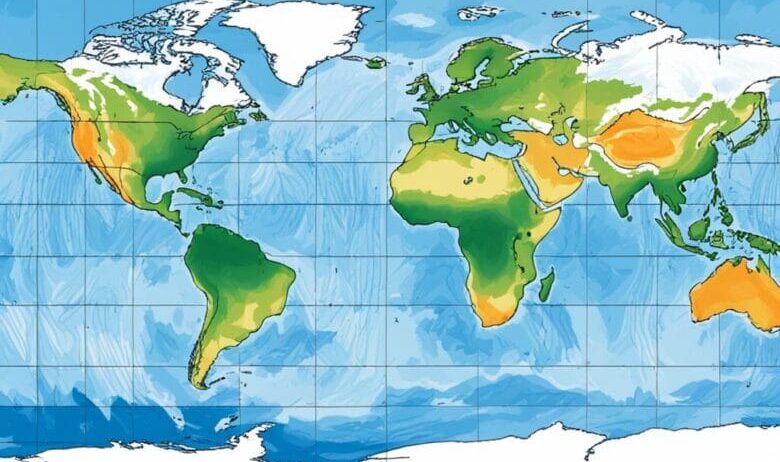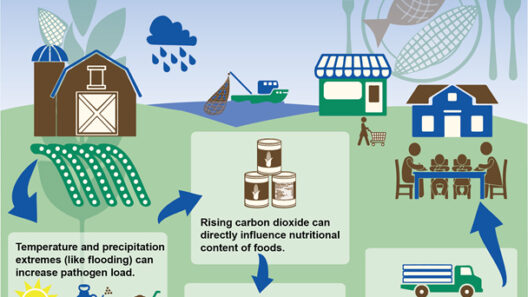Latitude plays a critical role in shaping the climate of various regions across the globe. This geographical coordinate influences temperature, precipitation patterns, and even biodiversity. Understanding how latitude affects climate can help us grasp the intricate balance of Earth’s ecosystems and the challenges posed by climate change.
In this article, we will explore how latitude determines climate diversity, the nuances of temperature variation, and the impact on ecosystems and human activity. From the frigid polar zones to the sizzling tropics, latitude is an essential thread woven into the fabric of climatic conditions.
The Latitude Spectrum: Understanding the Basics
Latitude is defined as the angle between the equatorial plane and a line drawn from the center of the Earth to a point on its surface. Ranging from 0° at the equator to 90° at the poles, this geographic measure divides the planet into distinct climatic zones. Each of these zones showcases unique temperature profiles and precipitation levels, influenced heavily by the sun’s angle during different times of the year.
Regions situated at low latitudes experience more direct sunlight, resulting in warmer temperatures year-round. Conversely, high-latitude areas are subjected to oblique sunlight, leading to cooler climates. The gradual change in solar energy distribution from the equator to the poles contributes to varied climate zones, including tropical, temperate, and polar climates.
Temperature Variation: A Latitude-Based Analysis
The relationship between latitude and temperature is profound and multifaceted. In tropical regions—located approximately between latitudes 0° and 23.5°—the sun’s rays strike directly throughout the year. This results in consistently high temperatures and minimal seasonal variation. The warm climate supports lush rainforests and a biodiversity hotspot, hosting countless plant and animal species that thrive in this environment.
As latitude increases beyond the tropics into the temperate zones (approximately 23.5° to 66.5°), temperature variability becomes more pronounced. These regions experience four distinct seasons: spring, summer, autumn, and winter. The tilt of the Earth’s axis leads to varying solar illumination throughout the year, causing warmer summers and colder winters. Consequently, temperate regions showcase diverse ecosystems ranging from deciduous forests to grasslands, adapting to seasonal changes.
High-latitude polar regions, above 66.5°, are characterized by extreme cold and prolonged periods of darkness during winter. With a limited growing season, the landscape is predominantly tundra with low-growing vegetation. These harsh conditions have led to unique adaptations among both flora and fauna, illustrating the extremes of life that can thrive even in the least hospitable climates.
The Precipitation Puzzle: How Latitude Dictates Rainfall
Precipitation patterns also reflect latitude’s influence, with distinct variations observed globally. Animal and plant life in any given region largely depend on the moisture levels present in their environment. In tropical latitudes, where high temperatures prevail, evaporation rates are elevated. This sets the stage for intense rainfall, often resulting in the establishment of rainforests that cradle a wealth of biodiversity.
In stark contrast, moving towards the subtropics (approximately 23.5° to 35°), one encounters the regions of descending air and high-pressure systems, which can lead to arid conditions. This phenomenon creates desert climates, where precipitation is scant and often unpredictable. Sand dunes, shrubs, and hardy shrubs prevail in these settings, along with specialized fauna capable of surviving with minimal water.
Continuing towards temperate latitudes, one finds that precipitation levels can vary significantly. Some temperate areas receive ample rainfall, while others may experience drier conditions, often dictated by geographic features such as mountain ranges. The orographic effect, where moist air rises over elevated terrains, fosters rain shadow regions that receive little precipitation, manifesting distinct ecological zones within a relatively short geographical span.
Human Implications: How Latitude Shapes Societies
The influence of latitude extends beyond natural ecosystems and into human societies. Climatic conditions precipitated by latitude determine agricultural practices, settlement patterns, and even cultural traditions. Tropical regions often enjoy year-round growing seasons, allowing for the cultivation of diverse crops. This agricultural bounty can support dense populations and lead to rich cultural heritages centered around agriculture.
In contrast, those residing in polar regions must contend with severe temperatures and ice-covered landscapes. Subsistence lifestyles often prevail, with indigenous populations relying on traditional practices that respect and utilize the natural resources available to them. The challenges of living in high-latitude areas necessitate remarkable adaptability and resilience among human communities.
Urban planning, architectural styles, and energy consumption are additionally shaped by the climate associated with latitude. For example, buildings in colder climates are designed to retain heat, whereas structures in tropical climates often prioritize ventilation and cooling techniques. As climate change accelerates, understanding the latitude-climate nexus becomes crucial for developing adaptive strategies that ensure sustainability and resilience in the face of shifting environmental conditions.
Conclusion: The Latitude Effect
Latitude is an indispensable determinant of climate, guiding temperature, precipitation, and biodiversity across the globe. As humanity grapples with the consequences of climate change, recognizing the effects of latitude is vital for adapting agricultural practices, conserving ecosystems, and managing urban environments. By appreciating the intricate relationship between latitude and climate, we can make informed decisions that promote ecological balance and sustainability in our diverse world.







